This week’s submission brings together a real odd couple. On the one hand, we have the Arkham Inmates, whose lengthy tenure in the game has come to little in terms of high-level success (with the exception of single cards like Poison Ivy, Deadly Rose and the infamous Justice League of Arkham). On the other, we have the Squadron Supreme, once the benchmark aggressive team but now fallen on hard times. Initially, they have little to recommend a team-up, but the eagle eyes of this week’s submitter picked out one Arkham legacy card that has the potential to do some serious damage in combination with the Squadron “no-hand” theme.
Submitter: Brad, via e-mail
Arkham Squadron
Characters
1 Haywire, Suicidal Lover
1 Quagmire, Jerome Meyers
1 Mr. Mxyzptlk, Troublesome Trickster
1 Amadeus Arkham, Architect of Insanity
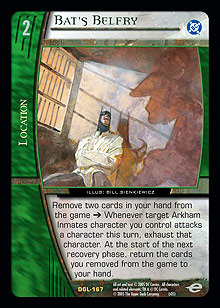 1 Mad Hatter, Jervis Tetch
1 Mad Hatter, Jervis Tetch
4 Poison Ivy, Deadly Rose
4 Charaxes, Drury Walker
1 Moonglow, Melissa Hanover
1 Hush, Mystery Man
4 Blue Eagle, James Dore Jr.
3 Scarecrow, Fearmonger
1 Albert Gaines ◊ Nuke, Atomic Powerhouse
1 Skymax, Skrullian Skymaster
2 Charaxes, Killer Moth
1 Arcanna, Arcanna Jones
1 Two-Face, Split Personality
Plot Twists
1 Sucker Punch
4 Nasty Surprise
4 Flying Kick
4 Kidnapping
1 Forbidden Loyalties, Team-Up
4 Crushing Blow
1 Smiles, Everyone!
4 Enemy of My Enemy
Location
1 Stormfront-1, Team-Up
1 Arkham Asylum
1 Slaughter Swamp
4 Bat's Belfry
1 Metropolis
The key to the deck is probably already clear: Bat’s Belfry. Neat, isn’t it? Keep two cards safely tucked away to enable your Squadron japes while exhausting your hapless opponent’s characters so that the Inmates can play practical jokes on them. Mostly practical jokes involving shotgun slugs or weird moth-people, but still funny, right? Right?
Brad identifies consistency as the main issue he’d like me to tackle with this deck, so that’s what I’ll focus on. If I come up with any neat tricks to throw into the mix while we’re at it, so much the better!
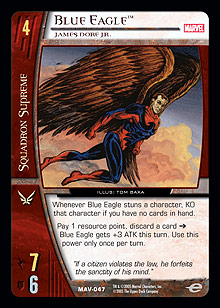 First, let’s flag up the two main mechanical themes of the deck. The first theme is the Squadron no-hand theme, represented most obviously by Blue Eagle, James Dore Jr. Enabling this theme ideally involves a Bat’s Belfry to keep cards safe for later turns, but can also be achieved by simply playing out our hand—particularly when we have reservist characters for later turns already tucked away neatly in the resource row.
First, let’s flag up the two main mechanical themes of the deck. The first theme is the Squadron no-hand theme, represented most obviously by Blue Eagle, James Dore Jr. Enabling this theme ideally involves a Bat’s Belfry to keep cards safe for later turns, but can also be achieved by simply playing out our hand—particularly when we have reservist characters for later turns already tucked away neatly in the resource row.
The second theme, and the one that occupies more space in the deck, is the Arkham “exhausted defenders” theme, stretching from Charaxes, Drury Walker to the copies of Crushing Blow and the lone Sucker Punch. Given that the natural state of defenders is “ready,” this is the theme that will require the most work to force our opponent to cooperate.
Usefully, both mechanical themes come together with a shared payoff: KO’ing our opponent’s characters simply by stunning them in combat. At the moment, the deck is leaning very heavily on Bat’s Belfry, which means either hitting Poison Ivy, Deadly Rose with a 1-drop or Haywire, Suicidal Lover, or naturally drawing the Belfry (ideally by turn 3 for Charaxes, Drury Walker’s power to kick in.) Essentially, there’s an imbalance between enablers for the exhaustion strategy and payoff cards. Put simply, there are too many cards like Crushing Blow and too few cards like Bat’s Belfry for the strategy to be as reliable as it could be. Thankfully, this is a fixable problem.
Looking at the more general structure of the deck, it’s currently running somewhat light on a number of key card types: team-ups, character search cards, and characters themselves (with only 3 team-ups, 4 character search cards, and 28 characters).
Before turning to the character curve, lets first see if we can pick out some additional search options. Team-ups are easy to add later, but it’s possible we’ll end up skewing our characters one way or the other to accommodate a particular second search card. The obvious options, given the lack of an Arkham team-stamped character search card, are Mobilize, Straight to the Grave, and Answer the Call. Each comes with its own advantages and disadvantages, but each is worthy of consideration. Mobilize has its usual drawback, which is that it never fetches your first character. Once your board is even slightly set up, Mobilize kicks into gear very nicely indeed, but until you have something on the board it’s a dead card. Straight to the Grave is incredible when it comes to finding what you want, but it needs additional help to get the card into play. It’s no good searching for Ivy on turn 2 if she’s just going to sit there mocking you from the KO’d pile. Answer the Call has the most potential for use, and like the others, requires a certain amount of setup (although of a different kind).
 In the end, I’ve decided to go with Straight to the Grave as the secondary character search card for the deck. This will involve playing more of the Avalon Space Station variants (probably including Avalon itself, along with Soul World), but those already have a use in our deck. Both assist us in using our KO’d pile as a proxy hand in which to store characters, and in recurring cards like Haywire (to KO to Poison Ivy), Quagmire, Jerome Meyers (as a combat trick) or Amadeus Arkham, Architect of Insanity (to directly search for locations). If we have nothing better to do, we can always play Straight to the Grave for no additional cost simply to get a card out of our hand (possibly putting Mr. Mxyzptlk, Troublesome Trickster into our KO’d pile for next turn). Oh, and if Skymax, Skrullian Skymaster ends up in the final list, Straight to the Grave will always find our 6-drop.
In the end, I’ve decided to go with Straight to the Grave as the secondary character search card for the deck. This will involve playing more of the Avalon Space Station variants (probably including Avalon itself, along with Soul World), but those already have a use in our deck. Both assist us in using our KO’d pile as a proxy hand in which to store characters, and in recurring cards like Haywire (to KO to Poison Ivy), Quagmire, Jerome Meyers (as a combat trick) or Amadeus Arkham, Architect of Insanity (to directly search for locations). If we have nothing better to do, we can always play Straight to the Grave for no additional cost simply to get a card out of our hand (possibly putting Mr. Mxyzptlk, Troublesome Trickster into our KO’d pile for next turn). Oh, and if Skymax, Skrullian Skymaster ends up in the final list, Straight to the Grave will always find our 6-drop.
At this point, I’d normally go through the character roster in a lot of detail, but I don’t think there’s that much of a need to with this list—the key characters are basically there, along with a pretty good proportion of the supporting cast. Instead of trawling through the whole list, I’ll just highlight some currently unused options of interest for each team.
Arkham Inmates
The Arkham Inmates provide the real backbone of the deck. They provide Bat’s Belfry itself, the location search to find it (in the form of Poison Ivy, Deadly Rose), and Charaxes, Drury Walker, one of the key exhaustion theme characters. Despite a relatively rough early period, powerhouse cards like Two-Face, Split Personality and the brutal Scarecrow, Fearmonger have improved the Arkham Inmates character base by leaps and bounds since the release of DC Origins.
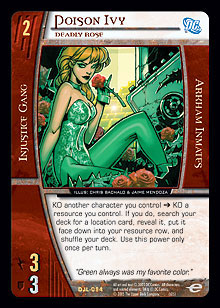 Running through the roster, there are key characters that are guaranteed slots: Poison Ivy, Deadly Rose; Charaxes, Drury Walker; and Scarecrow, Fearmonger. Of the Arkham characters not included in the original list, there are a number that I believe are worthy of consideration. Given our choice to go with a Straight to the Grave engine, Harley Quinn, Dr. Harleen Quinzel and Query and Echo, Double Trouble both join Quagmire, Jerome Meyers as character pseudo-plot twists. The Joker, Headline Stealer provides an interesting plot twist denial option alongside strong stats. Mr. Freeze, Dr. Victor Fries is a classic that still has some appeal, locking down defenders for your opponent’s next initiative.
Running through the roster, there are key characters that are guaranteed slots: Poison Ivy, Deadly Rose; Charaxes, Drury Walker; and Scarecrow, Fearmonger. Of the Arkham characters not included in the original list, there are a number that I believe are worthy of consideration. Given our choice to go with a Straight to the Grave engine, Harley Quinn, Dr. Harleen Quinzel and Query and Echo, Double Trouble both join Quagmire, Jerome Meyers as character pseudo-plot twists. The Joker, Headline Stealer provides an interesting plot twist denial option alongside strong stats. Mr. Freeze, Dr. Victor Fries is a classic that still has some appeal, locking down defenders for your opponent’s next initiative.
One potential issue with the original list is that it’s light on 2-drops (which it can’t search for that reliably, even with Straight to the Grave), and The Riddler, Brain Teaser provides a brand new option. Despite his relatively passive stats, The Riddler’s ability to lock out key plot twists can do some serious damage against certain decks. It can prevent the Kree from playing Remnant Fleet or Live Kree or Die!, for example, or it can lock the Teen Titans out of Teen Titans Go!. In short, if you like Anne-Marie Cortez, Acolyte and Null Time Zone, you should like the shiny new Riddler.
Squadron Supreme
The Squadron characters in the deck play more of a supplemental role, with Blue Eagle, James Dore Jr. the standout. Given the popularity of exhaustion-based stall decks, a copy of Golden Archer, Wyatt McDonald seems like a nice piece of insurance, while Whizzer, Stanley Stewart provides a much more interesting character than either Albert Gaines ◊ Nuke, Atomic Powerhouse or Scarecrow, Fearmonger against decks like Kree that aim to flood the board with small, easily reinforced characters. The traditional roster of no-hand characters are, of course, always options as well.
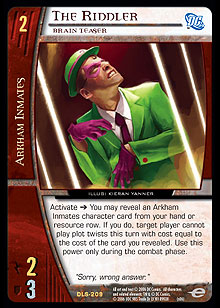 Taking those additional characters into account, along with the need to up the character count, I’m going to suggest the following character curve:
Taking those additional characters into account, along with the need to up the character count, I’m going to suggest the following character curve:
1 Haywire, Suicidal Lover
1 Quagmire, Jerome Meyers
1 Query and Echo, Double Trouble
1 Mr. Mxyzptlk, Troublesome Trickster
1 Amadeus Arkham, Architect of Insanity
4 Poison Ivy, Deadly Rose
4 The Riddler, Brain Teaser
4 Charaxes, Drury Walker
3 Lady Lark, Linda Lewis
4 Blue Eagle, James Dore Jr.
1 Golden Archer, Wyatt McDonald
3 Scarecrow, Fearmonger
1 Albert Gaines ◊ Nuke, Atomic Powerhouse
1 Whizzer, Stanley Stewart
1 Skymax, Skrullian Skymaster
The revised list should be more reliably aggressive, while at the same time it gains a little flexibility. The drops after 5 have been stripped down to the bare minimum—this isn’t a deck that ever wants to get to turn 7, and “recruit a 7-drop” simply isn’t good enough these days against decks dedicated to hitting the late game. If there’s anything that TDC Stall can handle, it’s 7-drop characters on turn 7 that need to attack. Play to your strengths. In this case, those strengths are turns 3-5—a brutal stretch of punishing tricks and characters that auto-KO.
If you do decide to beef up the late game, I recommend removing a copy of either The Riddler or Scarecrow for a second unique 6-drop rather than a 7-drop—probably Mr. Freeze, Dr. Victor Fries or Charaxes, Killer Moth. Another option for a 6-drop is the Thunderbolt Helmut Zemo ◊ Citizen V, Warmonger, who not only automatically teams-up adjacent characters, but also provides a +2 ATK / +2 DEF bonus to adjacent characters in combat with an exhausted defender. Another possible character splash can be found at the 5-drop slot. If your local area has a lot of decks that rely on a board of small, reinforced characters (with Catcher’s Mitt or Funeral For a Friend), you may want to consider replacing a copy of Scarecrow with a copy of Scorpion, MacDonald Gargan.
Now it’s resource time. As indicated earlier, the original list suffered from a bit of an imbalance when it came to the exhaustion theme, with payoff cards (like Crushing Blow) significantly outnumbering enablers (like Bat’s Belfry).
The tricky part—and this is probably the reason for the original imbalance—is that enablers aren’t sexy. When you look at a deck that likes attacking exhausted characters, what’s the first thing you look at? The big, splashy payoff. The auto-KO with Charaxes. The +3 ATK / +3 DEF on Crushing Blow. The Bamf! or the Sucker Punch. It’s easy to get carried away and fill up on the payoff cards because they’re the big, powerful effects, and end up not being able to reliably make use of those effects.
We want to up the enabler count without compromising our ability to smash face. Thankfully, there are changes we can make to help out.
Plot Twists
First of all, we’ll nail down our search cards: four copies each of Straight to the Grave and Enemy of My Enemy. That gives us a solid place to stand while we work on the rest. Looking at the original inclusions, a couple stand out as potential extra space. Nasty Surprise, while very powerful with Blue Eagle, James Dore Jr., is a little narrow. Kidnapping should also be unnecessary given that our 3-drop and 4-drop should both already be KO’ing anything they stun (the exhaust cost isn’t a big deal when we have Haywire). Flying Kick is always nice, but a little unimpressive given the natural flight on Charaxes and Blue Eagle. It’s good, but it’s not being used to its full potential (although adding a copy of Whizzer, Stanley Stewart has obviously given it some new mid-game potential).
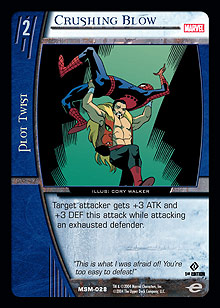 Crushing Blow is obviously pretty key. It does most of the work that Sucker Punch does while also actually assisting with stuns. There’s one card, however, that jumped immediately to mind when I looked at the original list, to the extent that I skipped down the list and looked for it as soon as I saw Charaxes: Glass Jaw. Packing as much of a punch as Flying Kick (with the advantage that it lasts for the turn, in case the first attack fails due to defensive pumps), Glass Jaw also gets that vital exhaustion in there. Fear and Confusion is the original exhaustion enabler, but the minor + ATK bonus it provides drops it down below both Glass Jaw and Belfry.
Crushing Blow is obviously pretty key. It does most of the work that Sucker Punch does while also actually assisting with stuns. There’s one card, however, that jumped immediately to mind when I looked at the original list, to the extent that I skipped down the list and looked for it as soon as I saw Charaxes: Glass Jaw. Packing as much of a punch as Flying Kick (with the advantage that it lasts for the turn, in case the first attack fails due to defensive pumps), Glass Jaw also gets that vital exhaustion in there. Fear and Confusion is the original exhaustion enabler, but the minor + ATK bonus it provides drops it down below both Glass Jaw and Belfry.
Locations
We already know that we’re going to want a few more locations here to help out with Straight to the Grave, to fetch back Haywire to once again KO to Ivy, and to reuse Quagmire or Amadeus Arkham. With Moonglow gone from the character list, the team-ups will all be locations too, along with the Belfry.
The singleton Arkham Asylum is nice, providing a reusable +2 ATK pump, but there are another couple of locations I want to bring up for consideration. The first is No Man’s Land as a singleton. Serving as both an exhaustion effect and a discard outlet with which to trim our hand down for Blue Eagle, it seems worth noting. The second location should give us a huge boost when it comes to damage races, and really lets us exploit the potential of this particular team-up. The card? Rocket Central. With Belfry and plenty of discard outlets, we should be able to reliably flip and use Rocket Central any time we have it in our row from turn 4 onwards.
Equipment
I won’t be including any equipment. There are two that would be nice, however. Sonic Gun plays into the theme while having some fringe benefits, but just isn’t powerful enough, and Thunder Jet would be amazing if we, uh, had any Thunderbolts.
Final List
This gives me enough to put together the final revised list. If you like the idea, put it together and take it out for a spin, and think about how to tweak it for the kinds of decks you play against. One card I would have really liked to find space for is Panacea Potion, to help keep Charaxes and Ivy around into the later turns.
Characters
1 Haywire, Suicidal Lover
1 Quagmire, Jerome Meyers
1 Query and Echo, Double Trouble
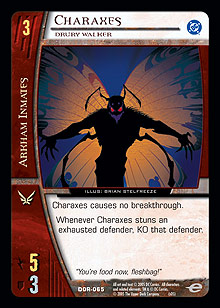 1 Mr. Mxyzptlk, Troublesome Trickster
1 Mr. Mxyzptlk, Troublesome Trickster
1 Amadeus Arkham, Architect of Insanity
4 Poison Ivy, Deadly Rose
4 The Riddler, Brain Teaser
4 Charaxes, Drury Walker
3 Lady Lark, Linda Lewis
4 Blue Eagle, James Dore Jr.
1 Golden Archer, Wyatt McDonald
2 Scarecrow, Fearmonger
1 Albert Gaines ◊ Nuke, Atomic Powerhouse
1 Whizzer, Stanley Stewart
1 Skymax, Skrullian Skymaster
1 Helmut Zemo ◊ Citizen V, Warmonger
Plot Twists
4 Enemy of My Enemy
4 Straight to the Grave
4 Glass Jaw
4 Crushing Blow
Locations
4 Bat’s Belfry
3 31st Century Metropolis, Team-Up
1 United Planets HQ, Team-Up
2 Slaughter Swamp
1 Soul World
1 Avalon Space Station
1 Rocket Central
1 Arkham Asylum
1 Sewer System
This is one of the better decks for Haywire I’ve seen so far. In stall decks, he gets exhausted for Rigged Elections or The Phantom Stranger, Wandering Hero, then gets KO’d to Ivy. In other decks he just gets KO’d to Ivy. In this deck, however, he can act more like a Pleasant Distraction when needed—target him with Bat’s Belfry, then send him into your opponent’s largest character to exhaust it at the cost of 0 stun endurance loss. You can even KO him to Ivy afterward if you like! Similarly, if you’ve played Glass Jaw on a character, you might as well send Haywire in first to get that exhaustion (for example, if you’re playing around a card like Insignificant Threat that could be played with the Glass Jaw trigger on the chain if you sent in Charaxes first). With Rocket Central, Haywire can even get up to a somewhat respectable ATK value and sneak in for a few points to the face once you’ve stunned your opponent’s board with proper characters.
One (quite important) point to make is that this isn’t like traditional Squadron. In most games, you won’t be trying to get to zero cards in hand, but to an even number of cards in hand. Bat’s Belfry can be used at any point in the turn as many times as you have pairs of cards in hand, and can target multiple characters. Got four cards in hand? You’re all good. Got three? Activate Soul World, play a plot twist, or do anything to change your hand size by one card either way and you’re gold. And don’t forget, if you have Ivy in hand on turn 1 . . . recruit that “plot twist” 1-drop. Attack for that point! Or even two points! Then feed the poor chump to the plants next turn.
Remember, if you have a deck that you’d like to see get the Deck Clinic treatment, e-mail me at vsdeckclinic@googlemail.com or post on the submission thread on VSRealms.com.
Tom Reeve is a member of the Anglo-Canadian Alliance (like the Rebel Alliance, but with public transport instead of X-Wings) and would-be professional layabout from London, England. While his love of all things ninja has resulted in an arguably unhealthy affinity for the League of Assassins, that particular quirk turned into a healthy plus with the birth of the Silver Age deck Deep Green, with which teammate Ian Vincent took home the Pro Circuit San Francisco trophy to dear old Blighty.